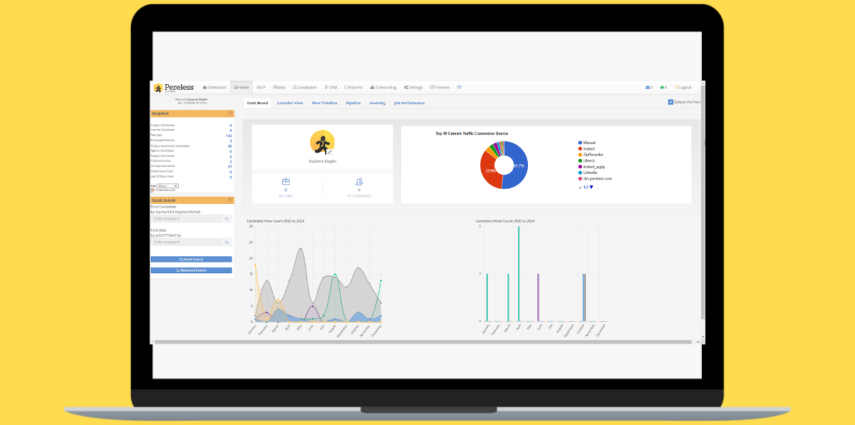In an era where smartphones are extensions of our very selves, the world of talent acquisition is undergoing a seismic shift. Picture this: A Gen Z candidate scrolling TikTok during a coffee break spots your job ad, applies in under 30 seconds, and responds to a text invite—all without ever touching a desktop. This isn’t sci-fi; it’s the new normal. As highlighted in ERE.net‘s insightful list of “25 Smart Recruiting Topics for Bold and Innovative Leaders,” catching up on mobile capabilities isn’t optional—it’s imperative. The article nails it: “The future of recruiting messaging and communications is the mobile platform. Every recruiting feature must be directly accessible from smartphones, and recruiting approaches must be tailored to fit the advantages of the mobile platform.” Companies like Sodexo, AT&T, and McDonald’s are already leading the charge, proving that mobile mastery can turn passive scrollers into proactive applicants.
But why now? Let’s dive into the data-driven reality of mobile recruiting in 2025 and explore how tools like Pereless Systems are paving the way for seamless, candidate-centric hiring.
The Explosive Rise of Mobile in Talent Acquisition
Smartphones aren’t just gadgets—they’re gateways to opportunity. With global smartphone subscriptions hitting 6.4 billion in 2022 and projected to surge past 7.7 billion by 2028, nearly everyone is reachable via their pocket device. Job seekers are no exception: Over 65% of applications are now submitted through mobile devices, making optimization a make-or-break factor for career sites and job boards. Meanwhile, 70% of hiring managers report success in filling roles via online platforms, with social media alone accounting for 98% of employer branding efforts and 65% of dedicated recruiting channels.
These stats underscore a broader trend: The average internet user spends 2.5 hours daily on social media, where quick, visual, and interactive content thrives. For recruiters, this means traditional desktop-heavy processes are relics. Candidates expect frictionless experiences—think one-tap applies during a commute or instant notifications that feel personal, not pushy. Ignore mobile, and you risk alienating 65% of your pool, watching top talent swipe right on competitors instead.
The Pitfalls of Lagging Behind: Why Non-Mobile ATS Are Costing You
Many organizations still cling to legacy systems designed for boardrooms, not backseats. The result? Clunky interfaces that load slowly on mobile, forms that require endless scrolling, and communications buried in email inboxes candidates check sporadically. This leads to sky-high drop-off rates—up to 80% on non-optimized pages—and prolonged time-to-hire, inflating costs by thousands per role.
As ERE points out, progress has been made, but gaps persist. Without mobile-tailored strategies, recruiters miss the platform’s superpowers: Location-based targeting (e.g., geo-fencing ads for local events), push notifications for real-time urgency, and bite-sized interactions that respect short attention spans. In a talent war where 32% of employers are already using AI for mobile screening, falling behind isn’t just inefficient—it’s existential.
Harnessing Mobile’s Advantages: Strategies for Innovative Leaders
To thrive, recruiting must evolve with the device. Start by ensuring every feature—from job postings to interviews—is smartphone-native. Tailor messaging for brevity and visuals: Emojis in texts outperform formal emails, and video snippets via mobile apps boost engagement by 3x. Leverage geolocation for hyper-local sourcing, like alerting nearby candidates to same-day shifts.
The key? Integrate tools that amplify mobile’s strengths while minimizing friction. This is where Applicant Tracking Systems (ATS) shine—or flop—depending on their design.
Pereless Systems: Your Mobile-First Ally in the Recruiting Revolution
At Pereless Systems, we’ve built our platform from the ground up for the mobile era, ensuring your entire hiring ecosystem is as agile as your candidates’ thumbs. With over 20 years of innovation, we’re not just compliant with mobile trends—we’re ahead of them, helping teams like yours reduce no-shows by 40% and accelerate hires by weeks.
Spotlight on Text Recruiting: Instant, Personal Connections
Forget email fatigue. Our Text Recruiting feature turns SMS into your superpower, reaching candidates where they live: on their phones. Send personalized alerts like “Hey Alex, your barista skills match our open shift—reply YES for a quick chat?” with one click. It’s compliant, scalable, and mobile-optimized, delivering 300% higher response rates than traditional methods. Tailored for on-the-go pros, texts respect mobile’s speed—candidates reply in minutes, scheduling interviews via integrated calendars without app downloads.
Mobile-Friendly Features That Seal the Deal
Every inch of Pereless Systems is smartphone-ready:
- One-Click Easy Apply: Frictionless forms load in seconds on any device, pre-filling or resumes—no endless typing during a lunch break.
- Branded, Responsive Career Pages: Custom, mobile-optimized portals that showcase your culture with swipeable galleries and embedded videos, boosting applications by 50%.
- Real-Time Notifications & Dashboards: Push alerts for new matches or interview slots, plus a sleek mobile app view for tracking pipelines anywhere.
- AI-Powered Matching on the Fly: Intelli-Match scans and ranks candidates via your phone, surfacing top fits with location-aware suggestions.
These aren’t add-ons—they’re core to our cloud-based ATS, ensuring seamless syndication to mobile-heavy boards. For growing teams, its affordable scalability: Start with unlimited postings and U.S.-based support.
*Recently, Pereless Systems launched their AI mascot named Bradford! Bradford has over 25 years of talent management experience. After every blog, Bradford will provide his expertise in the intricate world of talent management software like never before.*
What Would Bradford Do? Go Mobile or Go Home
As ERE wisely advises, bold leaders must “catch up” on mobile to stay competitive. In 2025, with billions glued to screens and applications skewing heavily mobile, ignoring this shift means leaving talent on the table. Embrace smartphone-first strategies, powered by tools like Pereless Systems, and watch your pipeline transform from stagnant to surging.
Ready to mobilize your recruiting? Schedule a free demo today and experience text recruiting magic firsthand!
Pereless Systems: Enterprise, powerful ATS for teams that hire to thrive.
Sources:
https://www.ere.net/articles/25-smart-recruiting-topics-for-bold-and-innovative-recruiting-leaders
https://www.aihr.com/blog/mobile-recruiting/
https://vouchfor.com/blog/online-recruitment-statistics
https://recruitcrm.io/blogs/recruiting-statistics/
https://www.selectsoftwarereviews.com/blog/recruiting-statistics
https://www.ihire.com/resourcecenter/employer/pages/the-state-of-online-recruiting-2025












